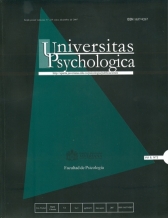Abstract
Resumen en ingles y en espanolEl trastorno por déficit de atención/hiperactivad (TDA/H) presenta síntomas heterogéneos y con diversos grados de intensidad. El análisis de conglomerados de clases latentes (ACCL) puede clasificar a los niños a partir de los datos directos provenientes de cualquier instrumento que muestre estos síntomas, sin un diagnóstico de patrón de oro previo. Se utilizó un instrumento tipo lista de chequeo para los síntomas de TDA/H y otro para las comorbilidades del TDA/H. ACCLs fueron aplicados para los datos de cada instrumento en una muestra aleatoria y representativa de 540 niños y adolescentes escolarizados de 4 a 17 años, de la ciudad de Manizales. Un análisis de correspondencias simples (ACS) fue usado para determinar la relación o concordancia de los grupos derivados de los ACCLs. Se encontraron seis clases para la lista de chequeo de síntomas de TDA/H y cinco para el instrumento de las comorbilidades de TDA/H. El ACS mostró cuatro grupos independientes, derivados de las concordancias entre las clases obtenidas de los dos instrumentos. Estos hallazgos sugieren que el ACCL y el ACS pueden ser usados como procedimientos taxométricos precisos para la clasificación de las psicopatologías por externalizaciónThis journal is registered under a Creative Commons Attribution 4.0 International Public License. Thus, this work may be reproduced, distributed, and publicly shared in digital format, as long as the names of the authors and Pontificia Universidad Javeriana are acknowledged. Others are allowed to quote, adapt, transform, auto-archive, republish, and create based on this material, for any purpose (even commercial ones), provided the authorship is duly acknowledged, a link to the original work is provided, and it is specified if changes have been made. Pontificia Universidad Javeriana does not hold the rights of published works and the authors are solely responsible for the contents of their works; they keep the moral, intellectual, privacy, and publicity rights. Approving the intervention of the work (review, copy-editing, translation, layout) and the following outreach, are granted through an use license and not through an assignment of rights. This means the journal and Pontificia Universidad Javeriana cannot be held responsible for any ethical malpractice by the authors. As a consequence of the protection granted by the use license, the journal is not required to publish recantations or modify information already published, unless the errata stems from the editorial management process. Publishing contents in this journal does not generate royalties for contributors.


